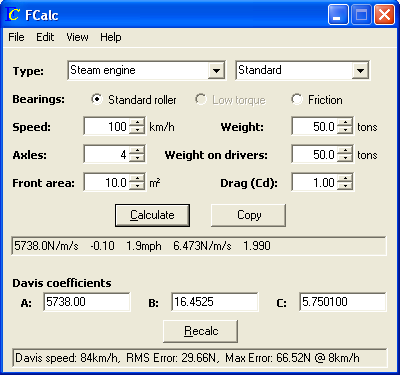As part of the work on the steam module, I decided to run my own "Rainhill Test". The purpose of the test was to see how the steam module would cope with an extremely lightly powered locomotive (Tractive effort of approximately 820lbf) A mere fraction of modern steam locomotives.
The original Rocket, by Joseph Spinella, is available from uktrainsim. The original model is set up to work in MSTS, and it appears to have been necessary to power the locomotive at more then its rated tractive effort in order to get it to move.
Testing with the new OR module, and lower power levels, also demonstrated a reluctance for the locomotive to move, and based upon research I believe that the current representation of friction in OR, which was based upon MSTS is not realistic, and especially the static (starting) friction which appears to be in excess of agreed railway industry figures. Most of my research has been based upon the information in the Baldwin Locomotive Data book - 1944.
As a result, I have made some modifications to the OR friction model based on this publication as follows:
i) Set the journal and roller bearing friction values at the values suggested
ii) Set different operation of roller and friction bearings between 5 and 35mph as described.
ii) Enabled OR to read the Davis values (as calculated with FCalc 2.0)
These changes will apply for all rolling stock and only come into effect if the new Davis values are included in the ENG or WAG file. If the Davis values are not present in the files then OR will default to the previous implementation of friction.
One way to get an appreciation of differences, if experimenting, is to watch the "HUD - Force Information" screen to see how the "Friction" value is changing.
The changes implemented model the differences for friction and roller bearings internally in the program, based upon the friction bearing as a reference, so the Davis values should be those calculated for friction bearings.
To set your stock up to take advantage of this you will need to add the following new OR parameters.
Wagon section of ENG file or WAG file.
Comment ( ********* Start OR Steam Module Parameters - Wagon Section ********* ) Comment ( Speed: 100km/h, Weight - 4.704 tons (US), Drv Weight - 2.191 tons (US), Drag - 1, Area - 2.5m2, Bearings - Friction, Axles - 2 (1 Drv, 1 aux), Type - Steam Locomotive Standard ) ORTSDavis_A ( 502.8 ) ORTSDavis_B ( 1.5465 ) ORTSDavis_C ( 1.437525 ) Comment ( ORTSBearingType ( Roller ) Comment ( If friction bearing, then leave out) ) Comment ( ********* Finish OR Steam Module Parameters ********* )
Engine section of ENG file
In addition to other OR parameters add this one, if appropriate:
ORTSDriveWheelWeight ( 2.12t ) Comment (If not steam locomotive, then leave out)
These changes have been implemented with #1978.
Cheers
Peter

 Log In
Log In Register Now!
Register Now! Help
Help








